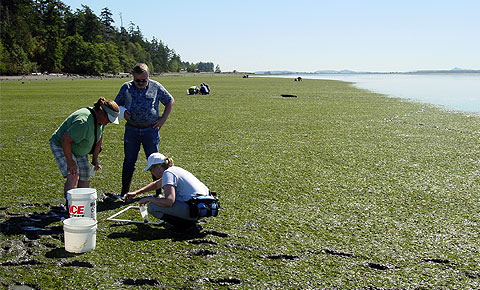Dr. Jude Apple's participation in the pelagic ecosystem function study is – in a reversal of the normal
process - a research area that arose from an existing education and outreach component. Jude and Dr. Jan
Newton, from the University of Washington, had been working together on several projects at
Northwest Indian College (NWIC),
bringing students out on the
RV Centennial. Meanwhile, Jan already
had in place a 7-year program of monitoring the conditions of the pelagic ecosystem in the San Juan Islands.
She was looking at the interactions between oceanography, chemistry, biology, plankton, oxygen concentration,
sea birds, mammals – all the components of the pelagic ecosystem. However, her program only took place from
September to December.
Jude was interested in extending the data collection to year round, and both of them were interested in
engaging underrepresented groups. Jude began sampling in January of 2011 and has done monthly sampling since
then, engaging students from the Multicultural Initiative in the Marine Sciences: Undergraduate Participation
(MIMSUP) program at
Western Washington University,
along with a group of citizen scientists. Summer interns from NWIC,
COSEE PRIME and
REU also participate.
"It's a great research platform - to investigate patterns throughout
the year and build an annual dataset. It's a great educational platform - to engage groups in hands-on
oceanographic inquiry-based learning about the San Juan Islands." |
Jude now has a year round data set, a powerful tool for looking at patterns and trends throughout the year.
He has recently applied to the NSF Ocean Acidification program for funding to support these oceanographic
surveys – particularly since a strong Broader Impacts component is already in place. "I was initially excited
about the education and outreach," says Jude. "Now I'm thinking about what analyses I can do with the
historical data, what questions to ask, and how to incorporate this into the suite of projects I can offer
to PRIME and REU and NWIC students."


